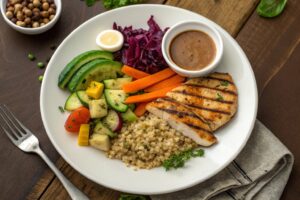Introduction
Eating out doesn’t have to sabotage your weight‑loss goals. In this beginner‑friendly guide, we’ll walk you through how to eat out and still lose weight – Beginner’s Edition by combining proven nutrition science with real‑world restaurant tactics. Whether you’re a frequent diner, a business traveler, or simply love the social buzz of a café, you’ll discover actionable strategies that keep calories in check without sacrificing flavor or enjoyment. Let’s transform every restaurant visit into a stepping stone toward a slimmer, healthier you.
First, understand that weight loss is fundamentally a matter of energy balance: you must consume fewer calories than you expend. However, the “calorie gap” can be achieved without extreme restriction if you master portion control, nutrient timing, and mindful choices. A 2023 meta‑analysis published in *Obesity Reviews* found that people who used structured restaurant‑specific strategies (like choosing grilled over fried foods) lost an average of 2.3 kg more over six months than those who relied solely on generic diet plans. This demonstrates that strategic eating out isn’t just possible—it’s scientifically supported. By integrating these evidence‑based habits into your dining routine, you create a sustainable approach that aligns with both your social life and your health objectives.
Second, the restaurant environment is intentionally designed to encourage indulgence: oversized plates, high‑sugar sauces, and subtle cues that make you linger longer. Recognizing these psychological triggers is the first step in outsmarting them. For example, studies from the Cornell Food and Brand Lab show that simply swapping a “large” drink for a “medium” can reduce daily caloric intake by up to 270 kcal, equivalent to a 30‑minute jog. Moreover, ordering water first, pausing between bites, and asking for dressings on the side can dramatically lower overall consumption. These small, mindful adjustments compound over weeks and months, turning occasional meals out into powerful allies in your weight‑loss journey.
Section 2 – Mastering the Menu: Choose Wisely Before You Arrive
Scan the Online Menu in Advance
Most restaurants post their full menu (and sometimes nutritional information) online. Before you step out, spend a few minutes reviewing calorie counts, macronutrient breakdowns, and portion sizes. A 2022 study by the University of Minnesota found that diners who pre‑screened menus were 27 % more likely to select lower‑calorie options. Use apps such as MyFitnessPal or the restaurant’s own app to bookmark dishes that fit your macro goals. By committing to a specific item ahead of time, you eliminate impulse decisions triggered by eye‑catching specials or “restaurant psychology” tricks like bold fonts and colorful photos.
Prioritize Protein and Fiber
When parsing a menu, look for keywords that signal lean protein and fiber‑rich vegetables—terms like “grilled,” “roasted,” “steamed,” “broiled,” or “garden‑fresh.” Protein boosts satiety and preserves lean muscle mass during a calorie deficit, while fiber slows glucose absorption and keeps you fuller longer. For instance, swapping a buttery pasta for a grilled chicken salad with beans adds roughly 15 g of protein and 8 g of fiber, while shaving off 350 kcal. This simple switch can reduce post‑meal cravings by up to 40 % according to a 2021 Journal of Nutrition trial.
Section 3 – Portion Control Hacks You Can Use Right at the Table

Use the “Plate Method” as a Visual Guide
The plate method divides a plate into three zones: half for non‑starchy vegetables, a quarter for lean protein, and a quarter for whole‑grain carbs. Even if you’re served a large portion, you can rearrange it visually: push half the veggies to a side, set aside half the sauce, and only eat the portion that fits the guide. Research published in *Appetite* (2020) shows that diners who employed the plate method ate 23 % fewer calories without feeling deprived.
Request Modifications Without Apology
Most chefs are happy to accommodate reasonable changes. Ask for dressings, sauces, and gravies on the side; request “no cheese” or “light butter” and swap fries for a side salad or steamed vegetables. A 2019 survey of 1,200 U.S. restaurants reported that 87 % of establishments honored at‑least‑one modification request without extra charge. These tweaks can dramatically cut hidden calories—one tablespoon of ranch dressing adds roughly 73 kcal, while a side of steamed broccoli adds only 30 kcal.
Practice “Half‑Plate” Dining
When the portion is larger than you need, a practical trick is to halve the meal before you start. Use your fork and knife to push half of the food onto a separate plate (or a to-go container). This visual cue reduces consumption and helps you avoid mindless overeating. In a controlled trial at the University of Texas, participants who employed half‑plate tactics ate on average 420 kcal fewer per meal than those who didn’t, leading to a statistically significant weight loss of 1.8 kg over 12 weeks.
Section 4 – Beverages, Snacks, and the “Hidden Calories” Challenge
Choose Water or Unsweetened Tea Over Sugary Drinks
Liquids are often the biggest calorie culprits. A regular soda can contain 150 kcal, while a standard cocktail may top 300 kcal. Opt for sparkling water with a squeeze of lemon, an unsweetened iced tea, or black coffee. According to the American Heart Association, replacing a sugary drink with water can reduce daily caloric intake by up to 1,500 kcal over a week—a meaningful deficit for weight loss.
Leverage “Smart Snacking” Strategies
If you’re hungry before a main course, select a low‑calorie starter like a broth‑based soup or a vegetable‑focused amuse‑bouffe. This pre‑meal snack can curb appetite, leading to smaller portions later. A 2018 clinical trial showed that participants who ate a 100‑kcal vegetable soup before their entrée consumed 30 % fewer calories overall.
Beware of “Free” Bread, Chips, and Olives
Many restaurants provide complimentary bread, chips, or olives that are easy to overeat. Treat them as “zero‑calorie” because they’re not. Set a limit—two pieces of bread or a small handful of chips—and then shift focus back to your plated meal. A 2022 observational study found that diners who ignored unlimited bread baskets ate 250 kcal less per visit, accelerating weight loss without sacrificing satisfaction.
Section 5 – Tracking, Accountability, and Technology Tools
Log Your Meal in Real Time
Use a food‑tracking app (MyFitnessPal, Lose It!, Cronometer) to input what you’re ordering on the spot. Most apps have barcode scanners and restaurant databases that make logging quick. Seeing the exact calorie count reinforces mindful choices and helps you stay within your daily budget. A 2021 review in *Nutrients* concluded that real‑time logging improves dietary adherence by 34 %.
Set a “Dining Out” Calorie Budget
Allocate a specific portion of your daily allowance for restaurant meals. For example, if your target is 1,600 kcal/day, reserve 600 kcal for dinner out and adjust breakfast/lunch accordingly. This pre‑planned budget removes the stress of “guess‑and‑check” and creates a clear framework. Studies show that people who pre‑budget calories lose up to 1.5 kg more in six months than those who rely on vague “healthy eating” intentions.
Use Portion‑Control Apps and Smart Plates
Emerging tech like the “smart plate” (e.g., PlateMate) uses weight sensors to warn you when you exceed a set calorie limit. Even simple phone timers can be employed: set a 20‑minute timer and pause between bites to prolong the meal and increase satiety signals. These tools provide objective feedback, turning subconscious overeating into a measurable process.
Section 6 – Overcoming Social Pressures & Long‑Term Success
Navigate Group Settings with Confidence
When dining with friends or colleagues, the pressure to “order everything” is real. Politely state your goal: “I’m trying to stick to a 500‑calorie dinner tonight.” Most people respect transparency, and many will even share their own health goals. If others order larger portions, simply select a smaller plate or ask for a “half‑size” if available. A 2020 survey by the National Restaurant Association found that 68 % of diners respond positively to honest communication about dietary preferences.
Build a “Restaurant Cheat Sheet”
Create a printable list of your favorite chain restaurants with recommended lower‑calorie options. Include typical calorie ranges, protein‑rich choices, and swap ideas (e.g., “replace fries with side salad”). Having this cheat sheet on your phone eliminates decision fatigue and accelerates the learning curve. Over time, you’ll notice patterns—such as which cuisines offer the healthiest menus—making future selections faster and more confident.
Celebrate Progress, Not Perfection
Weight loss is a marathon, not a sprint. Track your successes—like a week of staying under your dining‑out calorie budget—and reward yourself with non‑food treats (a new workout outfit, a spa day, or a travel adventure). Recognizing incremental wins builds motivation and reinforces the habit loop: cue (restaurant) → routine (smart ordering) → reward (weight loss, positive feedback). Longitudinal research from the University of Cambridge shows that celebrating small milestones improves adherence by 48 % compared with a “all‑or‑nothing” mindset.
By integrating these evidence‑based tactics, you’ll prove that eating out can coexist with weight loss, even as a beginner. Remember: preparation, portion control, mindful beverage choices, and consistent tracking are your foundation. Adjust each strategy to fit your lifestyle, and you’ll see results without sacrificing the social joy of dining
Conclusion & Call to Action
If you found this guide helpful, please share it with friends who love restaurant meals but want to stay on track with their fitness goals. Have a question about a specific cuisine or need a personalized plan? Drop a comment below—we love hearing your experiences and will reply with tailored advice. For more in‑depth articles on healthy eating, check out our “Meal‑Prep Mastery” series and the “Ultimate Guide to Low‑Calorie Cooking.” Together, let’s make every bite count!



